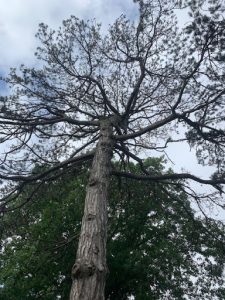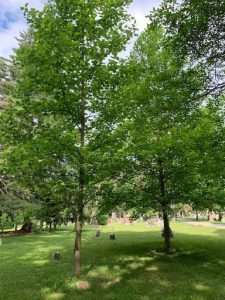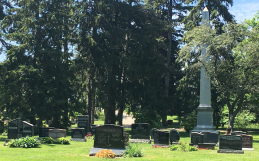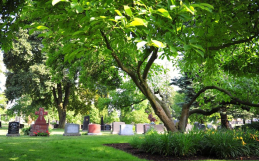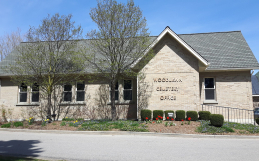Written by Paul Taylor
“Trees exhale for us so that we can inhale them to stay alive. Can we ever forget that? Let us love trees with every breath we take until we perish.”
― Munia Khan
Woodlawn’s Historical Urban Forest
Elm Tree History
During a recent walk through Woodlawn Memorial Park, I heard something unsettling: The sound of chainsaws. Sure enough, more trees need to be taken down and removed for safety.
This is not new for Woodlawn, nor for the community of Guelph.
43 years ago, when I began my career with The Guelph Cemetery Commission, I remember hearing stories from avid walkers about the many stately elm trees that once lined the roads of Woodlawn. They gave shade to the visitors, the plants, and wildlife. What happened to them? They were lost to Dutch elm disease. It wiped out all the elm trees we had. Woodlawn lost decades of tree growth in a matter of just a few years.
As the elms died, we brought out the chainsaws and had them removed for safety. Large holes were left in the natural canopy of Woodlawn. By the time I arrived at Woodlawn Memorial Park, all of the original elms had been removed, but not lost forever. Out of the many shrubs throughout the grounds, elm seedlings started to grow. After a few years, these seedlings became substantial young trees! After a couple of decades, these seedlings turned into good-sized trees and then something worrisome started to happen again. One-by-one they died and needed to be removed over the next 20 years. Today, two of those last elm trees have begun a fast decline and will soon need to be removed for safety. The loss of these stately old elms has changed the look of Woodlawn forever.
For 166 years of Woodlawn’s history, park overseers have been planting and growing trees with the cycle of having to be removed. It’s ongoing. With the size of our urban forest we often are visited by people who come just to see our trees — we have some of the largest trees in Guelph.
Our Austrian Pines
At one time, we had the largest Austrian pines I had ever seen. Many had brown tips on their needles and I soon learned they were being affected by a needle blight.
I was told the blight would eventually destroy all our Austrian pines, but it may take up to 20 years. Fortunately, many of them lasted closer to 40 years and are now needing to be removed. Here we go again.
Over the last five years, we have lost three-quarters of our Austrian pines. These trees could reach over 100 feet into the sky, casting their shadows all year long over many acres of Woodlawn. Sadly, we expect that in a few more years they will all be gone from the grounds of Woodlawn.
Scotch pines are another specimen that we have been losing over the past decade. Recently, four of these trees were removed. After counting the year rings we discovered they were all over 125 years old. Just think of the history they have lived through. This is truly why we say that Woodlawn’s history is deeply rooted in trees.
Woodlawn’s Reality Today
The Ash Borer from Canada’s East Coast has made its way to Ontario and, unfortunately, into Woodlawn. Our ash trees are not as large as our elms or Austrian pines were, nor do we have as many, but I am sure of one thing: Eventually, they will all be lost.
The Ash Borers have begun their course of destruction on our 80 acres of beauty. Seven ash trees have been removed in the past three weeks. Over the next seven weeks, we expect the last one will be removed from the grounds.
Hundreds of trees have been removed from our landscape fabric over the past 50 years, leaving holes in our tree canopy. Some were lost through wind or snowstorms, some by old age, others by disease and insects. Woodlawn has done it’s best over the decades to replace as many as we could, but it has not been enough.
How You Can Help Save Our Trees
Over 30 years ago we started a special fund for donations to help fill in our tree canopy. It’s called the Woodlawn Arbour Fund. This is a charitable fund where we use donations to plant more trees and shrubs on the grounds of Woodlawn.
If you enjoy walking through Woodlawn Memorial Park and appreciate the wonderful cool shade that our trees cast, their beauty, and how deeply rooted Woodlawn’s history is in trees, there are ways you can help.
Contact us to donate to the Woodlawn Arbour Fund. You can donate in memory of a loved one or to support the tremendous, positive impact that trees have on our planet.
Like people, trees have life spans too. Become a part of Woodlawn Memorial Park’s landscape so that future generations can enjoy walking through Guelph’s historical park one step at a time and appreciate the beauty of our trees.

